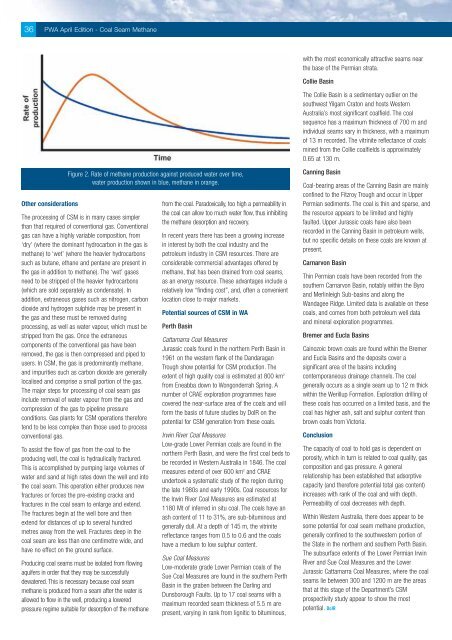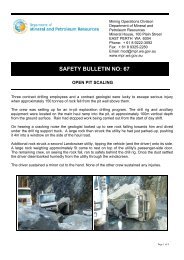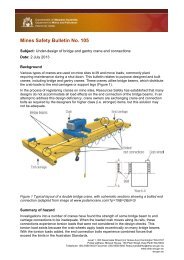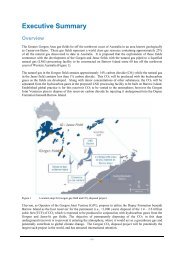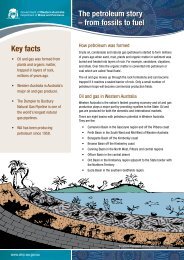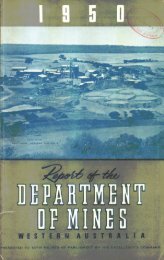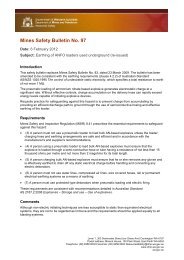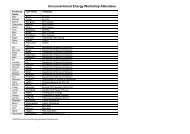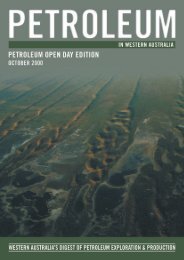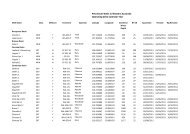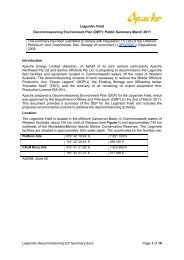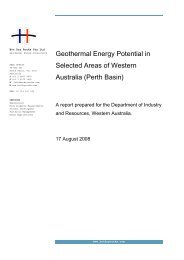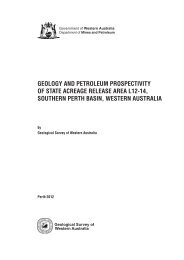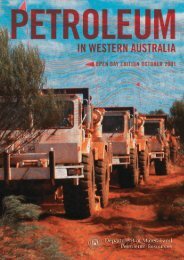IN WESTERN AUSTRALIA - Department of Mines and Petroleum
IN WESTERN AUSTRALIA - Department of Mines and Petroleum
IN WESTERN AUSTRALIA - Department of Mines and Petroleum
Create successful ePaper yourself
Turn your PDF publications into a flip-book with our unique Google optimized e-Paper software.
36<br />
PWA April Edition - Coal Seam Methane<br />
Other considerations<br />
Figure 2. Rate <strong>of</strong> methane production against produced water over time,<br />
water production shown in blue, methane in orange.<br />
The processing <strong>of</strong> CSM is in many cases simpler<br />
than that required <strong>of</strong> conventional gas. Conventional<br />
gas can have a highly variable composition, from<br />
‘dry’ (where the dominant hydrocarbon in the gas is<br />
methane) to ‘wet’ (where the heavier hydrocarbons<br />
such as butane, ethane <strong>and</strong> pentane are present in<br />
the gas in addition to methane). The ‘wet’ gases<br />
need to be stripped <strong>of</strong> the heavier hydrocarbons<br />
(which are sold separately as condensate). In<br />
addition, extraneous gases such as nitrogen, carbon<br />
dioxide <strong>and</strong> hydrogen sulphide may be present in<br />
the gas <strong>and</strong> these must be removed during<br />
processing, as well as water vapour, which must be<br />
stripped from the gas. Once the extraneous<br />
components <strong>of</strong> the conventional gas have been<br />
removed, the gas is then compressed <strong>and</strong> piped to<br />
users. In CSM, the gas is predominantly methane,<br />
<strong>and</strong> impurities such as carbon dioxide are generally<br />
localised <strong>and</strong> comprise a small portion <strong>of</strong> the gas.<br />
The major steps for processing <strong>of</strong> coal seam gas<br />
include removal <strong>of</strong> water vapour from the gas <strong>and</strong><br />
compression <strong>of</strong> the gas to pipeline pressure<br />
conditions. Gas plants for CSM operations therefore<br />
tend to be less complex than those used to process<br />
conventional gas.<br />
To assist the flow <strong>of</strong> gas from the coal to the<br />
producing well, the coal is hydraulically fractured.<br />
This is accomplished by pumping large volumes <strong>of</strong><br />
water <strong>and</strong> s<strong>and</strong> at high rates down the well <strong>and</strong> into<br />
the coal seam. This operation either produces new<br />
fractures or forces the pre-existing cracks <strong>and</strong><br />
fractures in the coal seam to enlarge <strong>and</strong> extend.<br />
The fractures begin at the well bore <strong>and</strong> then<br />
extend for distances <strong>of</strong> up to several hundred<br />
metres away from the well. Fractures deep in the<br />
coal seam are less than one centimetre wide, <strong>and</strong><br />
have no effect on the ground surface.<br />
Producing coal seams must be isolated from flowing<br />
aquifers in order that they may be successfully<br />
dewatered. This is necessary because coal seam<br />
methane is produced from a seam after the water is<br />
allowed to flow in the well, producing a lowered<br />
pressure regime suitable for desorption <strong>of</strong> the methane<br />
from the coal. Paradoxically, too high a permeability in<br />
the coal can allow too much water flow, thus inhibiting<br />
the methane desorption <strong>and</strong> recovery.<br />
In recent years there has been a growing increase<br />
in interest by both the coal industry <strong>and</strong> the<br />
petroleum industry in CSM resources. There are<br />
considerable commercial advantages <strong>of</strong>fered by<br />
methane, that has been drained from coal seams,<br />
as an energy resource. These advantages include a<br />
relatively low “finding cost”, <strong>and</strong>, <strong>of</strong>ten a convenient<br />
location close to major markets.<br />
Potential sources <strong>of</strong> CSM in WA<br />
Perth Basin<br />
Cattamarra Coal Measures<br />
Jurassic coals found in the northern Perth Basin in<br />
1961 on the western flank <strong>of</strong> the D<strong>and</strong>aragan<br />
Trough show potential for CSM production. The<br />
extent <strong>of</strong> high quality coal is estimated at 800 km 2<br />
from Eneabba down to Wongonderrah Spring. A<br />
number <strong>of</strong> CRAE exploration programmes have<br />
covered the near-surface area <strong>of</strong> the coals <strong>and</strong> will<br />
form the basis <strong>of</strong> future studies by DoIR on the<br />
potential for CSM generation from these coals.<br />
Irwin River Coal Measures<br />
Low-grade Lower Permian coals are found in the<br />
northern Perth Basin, <strong>and</strong> were the first coal beds to<br />
be recorded in Western Australia in 1846. The coal<br />
measures extend <strong>of</strong> over 600 km 2 <strong>and</strong> CRAE<br />
undertook a systematic study <strong>of</strong> the region during<br />
the late 1980s <strong>and</strong> early 1990s. Coal resources for<br />
the Irwin River Coal Measures are estimated at<br />
1180 Mt <strong>of</strong> inferred in situ coal. The coals have an<br />
ash content <strong>of</strong> 11 to 31%, are sub-bituminous <strong>and</strong><br />
generally dull. At a depth <strong>of</strong> 145 m, the vitrinite<br />
reflectance ranges from 0.5 to 0.6 <strong>and</strong> the coals<br />
have a medium to low sulphur content.<br />
Sue Coal Measures<br />
Low-moderate grade Lower Permian coals <strong>of</strong> the<br />
Sue Coal Measures are found in the southern Perth<br />
Basin in the graben between the Darling <strong>and</strong><br />
Dunsborough Faults. Up to 17 coal seams with a<br />
maximum recorded seam thickness <strong>of</strong> 5.5 m are<br />
present, varying in rank from lignitic to bituminous,<br />
with the most economically attractive seams near<br />
the base <strong>of</strong> the Permian strata.<br />
Collie Basin<br />
The Collie Basin is a sedimentary outlier on the<br />
southwest Yilgarn Craton <strong>and</strong> hosts Western<br />
Australia’s most significant coalfield. The coal<br />
sequence has a maximum thickness <strong>of</strong> 700 m <strong>and</strong><br />
individual seams vary in thickness, with a maximum<br />
<strong>of</strong> 13 m recorded. The vitrinite reflectance <strong>of</strong> coals<br />
mined from the Collie coalfields is approximately<br />
0.65 at 130 m.<br />
Canning Basin<br />
Coal-bearing areas <strong>of</strong> the Canning Basin are mainly<br />
confined to the Fitzroy Trough <strong>and</strong> occur in Upper<br />
Permian sediments. The coal is thin <strong>and</strong> sparse, <strong>and</strong><br />
the resource appears to be limited <strong>and</strong> highly<br />
faulted. Upper Jurassic coals have also been<br />
recorded in the Canning Basin in petroleum wells,<br />
but no specific details on these coals are known at<br />
present.<br />
Carnarvon Basin<br />
Thin Permian coals have been recorded from the<br />
southern Carnarvon Basin, notably within the Byro<br />
<strong>and</strong> Merlinleigh Sub-basins <strong>and</strong> along the<br />
W<strong>and</strong>agee Ridge. Limited data is available on these<br />
coals, <strong>and</strong> comes from both petroleum well data<br />
<strong>and</strong> mineral exploration programmes.<br />
Bremer <strong>and</strong> Eucla Basins<br />
Cainozoic brown coals are found within the Bremer<br />
<strong>and</strong> Eucla Basins <strong>and</strong> the deposits cover a<br />
significant area <strong>of</strong> the basins including<br />
contemporaneous drainage channels. The coal<br />
generally occurs as a single seam up to 12 m thick<br />
within the Werillup Formation. Exploration drilling <strong>of</strong><br />
these coals has occurred on a limited basis, <strong>and</strong> the<br />
coal has higher ash, salt <strong>and</strong> sulphur content than<br />
brown coals from Victoria.<br />
Conclusion<br />
The capacity <strong>of</strong> coal to hold gas is dependent on<br />
porosity, which in turn is related to coal quality, gas<br />
composition <strong>and</strong> gas pressure. A general<br />
relationship has been established that adsorptive<br />
capacity (<strong>and</strong> therefore potential total gas content)<br />
increases with rank <strong>of</strong> the coal <strong>and</strong> with depth.<br />
Permeability <strong>of</strong> coal decreases with depth.<br />
Within Western Australia, there does appear to be<br />
some potential for coal seam methane production,<br />
generally confined to the southwestern portion <strong>of</strong><br />
the State in the northern <strong>and</strong> southern Perth Basin.<br />
The subsurface extents <strong>of</strong> the Lower Permian Irwin<br />
River <strong>and</strong> Sue Coal Measures <strong>and</strong> the Lower<br />
Jurassic Cattamarra Coal Measures, where the coal<br />
seams lie between 300 <strong>and</strong> 1200 m are the areas<br />
that at this stage <strong>of</strong> the <strong>Department</strong>’s CSM<br />
prospectivity study appear to show the most<br />
potential. DoIR


